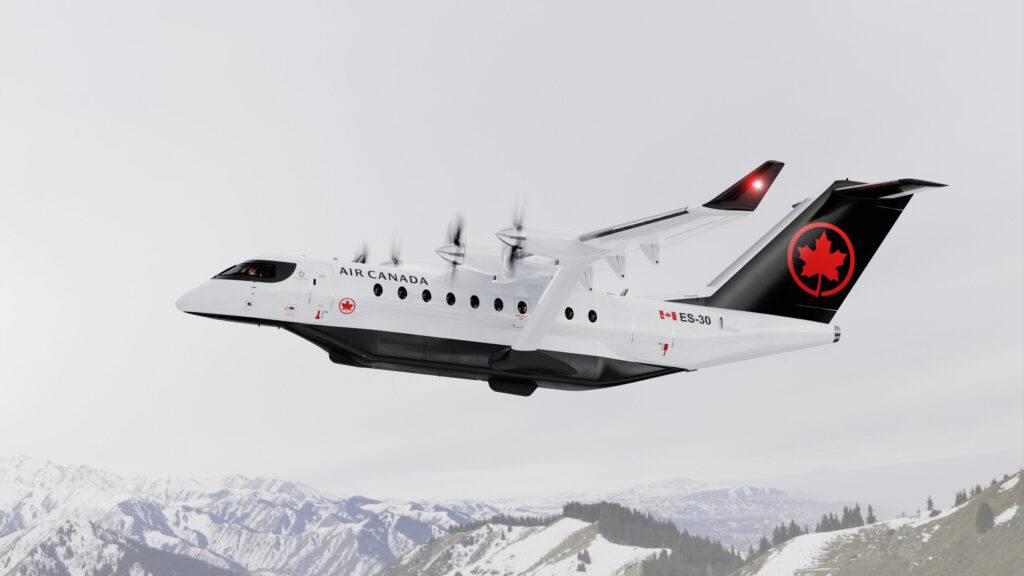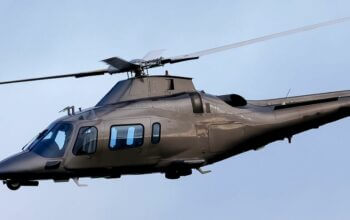Estimated reading time 4 minutes, 28 seconds.
Air Canada announced on Sept. 15 that it has agreed to purchase 30 ES-30 electric-hybrid aircraft, currently being developed by Swedish manufacturer Heart Aerospace. The agreement also includes a US$5 million equity investment by Air Canada in Heart Aerospace.
The ES-30, which is expected to enter service in 2028, is a newly announced, updated design to Heart Aerospace’s earlier 19-seat ES-19 aircraft. The updated aircraft design will allow for 30 passengers seated three across (in a 2×1 configuration).

The ES-30 will be driven by electric motors powered by batteries, allowing it to operate with zero emissions and “yield significant operational savings and benefits.” Acquiring the regional electric aircraft will bring Air Canada closer to the industry-wide goal of net-zero emissions by 2050.
“Already, Air Canada is supporting the development of new technologies, such as sustainable aviation fuels and carbon capture to address climate change,” said Michael Rousseau, president and CEO of Air Canada. “We are now reinforcing our commitment by investing in revolutionary electric aircraft technology, both as a customer for the ES-30 and as an equity partner in Heart Aerospace.”
As Canada’s largest airline, Air Canada currently provides scheduled passenger service directly to 51 airports in Canada, 51 in the United States, and 86 internationally. The airline says the ES-30 will allow it to serve regional and commuter routes more sustainably over the medium-to-long term.
Powered by lithium-ion batteries, the ES-30 is expected to be quieter, have better operational parameters, be more reliable, and have a smaller environmental footprint than conventional turboprop aircraft. It will also be equipped with reserve-hybrid generators that can use sustainable aviation fuel.
“The reserve-hybrid system is installed to secure reserve energy requirements without cannibalizing battery range, and it can also be used during cruise on longer flights to complement the electrical power provided by the batteries,” said Heart Aerospace in a press release.
Fully loaded, the ES-30 is projected to have an all-electric, zero-emission range of 200 kilometers. According to Heart, the range could be extended to 400 km with power supplemented by the generators, and up to 800 km if the load is restricted to 25 passengers. The manufacturer expects the aircraft will be able to charge in 30 to 50 minutes.
While other companies, including United Airlines and Mesa Air Group, had already placed orders for a total of 200 ES-19 aircraft (with an option for an addition 100 planes), Heart Aerospace said those orders have been reconfirmed for the updated ES-30 design.
“In addition to those commitments, many of the ES-19 letters of intent (LOI) holders have already updated their respective letters to reflect the ES-30,” the company said. “These include the Nordic airlines Braathens Regional Airlines, Icelandair, and SAS, as well as New Zealand’s Sounds Air,” and Swedish-based lessor, Rockton.
In total, Heart Aerospace has LOIs for 96 ES-30s.









According to the images displayed, the Heart Aerospace ES-30 has deicing pads on the wings and tailplane, but not on the wing strut. Big mistake – strut deicing will absolutely prove to be necessary and should be incorporated from the start.
200 km range? Not including an alternate or ground delays. At least the seating will be executively configured
look like a Dornier 328.. must not have de icing on the prop as well. I think it is a bit early for such comment you must think peoples are really bad.